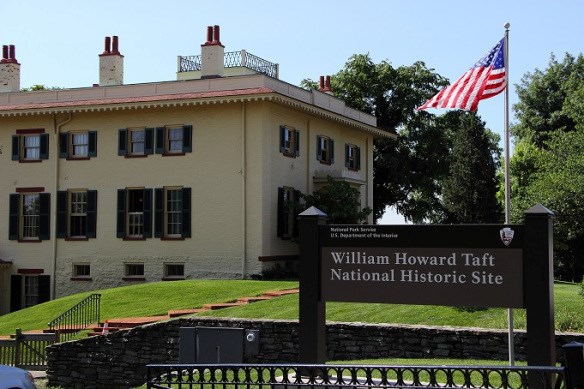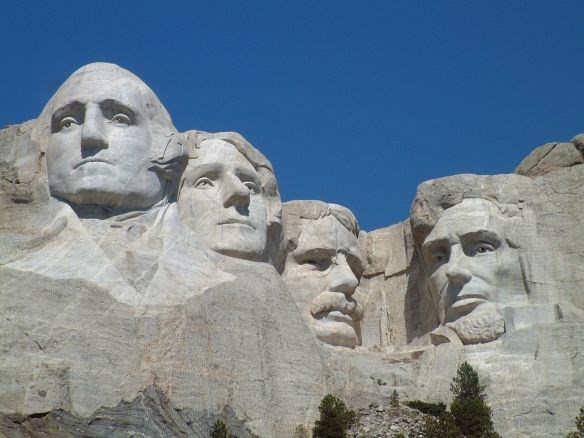Last updated: October 30, 2020
Article
Four Hundred and Eight Strong

NPS photo
Imagine stepping back in time to an elegant country estate, and standing on a front porch where a presidential candidate once spoke to thousands of people. Envision a quiet island corridor between Put-in-Bay and the Ohio coast, the same place where the naval Battle of Lake Erie was waged over 200 years ago. Picture yourself walking a peaceful riverside trail, where commerce and community formerly thrived upon the Ohio and Erie Canal.
These are just a few of the scenes preserved and protected by the National Park Service (NPS), and the best part is they are all right here in Ohio. And for park rangers, these scenes are just another day at the office!
The National Park Service (NPS) is an agency of the federal government, operating within the Department of the Interior. The parks that make up the system are further divided into 7 regions: Alaska, Intermountain, Midwest, National Capital, Northeast, Pacific West, and Southeast. Ohio falls within the Midwest Region, which includes parks in or near urban areas like Cuyahoga Valley National Park and Jefferson National Expansion Memorial, varied landscapes such as Sleeping Bear Dunes National Lakeshore and Tallgrass Prairie National Preserve, and historic locations like our own James A. Garfield National Historic Site. James A. Garfield National Historic Site (or JAGA, as it is affectionately abbreviated) is one of 408 National Park Service units across the United States, plus the District of Columbia, American Samoa, Guam, Puerto Rico, and the Virgin Islands. Every state has at least one National Park unit (Delaware was the last state to join the list, with the addition of First State National Historical Park, which includes the First State National Monument, in March 2013).

NPS photo
Work within the NPS is generally divided among six main divisions responsible for various aspects of park management. Each division typically includes a chief as well as other management staff who oversee the operations. The division names and functions may vary slightly from one site to another, but the general structure and responsibilities are similar:
Superintendent’s Office
A superintendent and his or her staff oversee all park divisions and activities. This office may also work and communicate with surrounding communities and organizations.
Administrative
The administrative staff manages many functions, including human resources and payroll, budget planning, information technology, property management and acquisition, and purchasing and contracting.
Interpretation, Education, and Visitor Services
IEVS rangers are the staff with whom visitors are most likely to interact on a visit. Interpretive rangers can be found working in visitor centers, leading tours and guided hikes, presenting educational programs to students, supervising volunteers, and organizing special events. Interpretive rangers are also busy behind the scenes, planning programs, creating brochures and park literature, and keeping the park’s website and social media accounts current.
Maintenance employees are responsible for upkeep of the park and its facilities, whether that is cleaning and servicing the buildings and grounds used by the public, constructing and maintaining trails, or keeping areas cleared of snow in the winter months. Some maintenance staff members, like automotive technicians, work on specialized projects depending on the needs of the site.
Visitor and Resource Protection
Visitor and resource protection Rangers are the law enforcement division of a park. These rangers are trained in first aid and incident response, so that in an emergency, they can quickly reach a victim or situation and assist. They also maintain internal communications, such as radio traffic, weather-related news, and employee contact information, and monitor park security systems.

NPS photo
Resource Management
Each park within NPS has a unique set of resources, which could include historical buildings or structures, original artifacts or documents, and natural features. Resource management could involve ecosystem management, such as invasive species or water quality monitoring, or protection of cultural and historical resources, like curating a museum collection or archaeological artifacts.
Although tasks and projects are divided amongst divisions, cooperation between them is essential in order for parks to function well. Beyond these park-level divisions, there are also regional offices for each of the seven regions. These regional offices report to the Washington, D.C. offices, the highest level in the park’s organization. Regional offices may handle affairs that cannot be handled internally at the park level, while the Washington offices handle matters at the nationwide level.
Some visitors are also curious about how one comes to work for the National Park Service in the first place. While working in or visiting a park, you might encounter people with all sorts of educational backgrounds: natural resource management, biology, fisheries and wildlife, history, social science/anthropology, park and recreation management, law enforcement, museum studies, business administration, public administration, or any number of other degrees. Many park employees begin their careers as seasonal staff or interns. Still others have worked in a variety of other industries or environments, such as experience as an educator, military veteran, outdoor recreation instructor, or park volunteer, before joining the staff.
NPS in Ohio
Ohio is home to eight National Park Service units:
- Charles Young Buffalo Soldiers National Monument (Wilberforce)
- Cuyahoga Valley National Park (Cleveland-Akron)
- Dayton Aviation Heritage National Historical Park (Dayton)
- First Ladies National Historic Site (Canton)
- Hopewell Culture National Historical Park (Chillicothe)
- James A. Garfield National Historic Site (Mentor)
- Perry’s Victory and International Peace Memorial (Put-in-Bay)
- William Howard Taft National Historic Site (Cincinnati)
Not included on this list are some of the other NPS designations that are affiliated with the National Park Service (for example, the North Country National Scenic Trail, which runs through Ohio as well as six other states).

NPS photo
Types of NPS Units
Keeping track of all the different designations can be a little confusing, but not to worry—just focus on learning something, having fun, and enjoying your visit! It is helpful, though, to know a little bit about the different types of parks, so you can know some of what to expect when you take your next visit (examples of each designation are in parentheses):
National Park (Acadia)
With 59 units, National Parks are some of the most recognizable and well-known units of NPS. These are generally large, natural places having a wide variety of attributes, often including significant historic or cultural elements. Hunting, mining, and consumptive activities (like collecting fossils or plants) are not authorized within units of this variety.
National Monument (Fort Sumter)
A National Monument could be something constructed (like a statue or fort) or something natural (such as a geologic feature). Devils Tower in Wyoming was the first national monument, established by President Theodore Roosevelt in 1906. The Antiquities Act earlier that year authorized the president to declare landmarks, structures, and other objects of historic or scientific interest as national monuments.
National Preserve (Big Cypress)
National preserves are similar to national parks, but allow a wider range of activities within their borders, such as hunting, trapping, and oil extraction. Many existing national preserves, without sport hunting, would qualify for national park designation.
National Historic Site (Clara Barton)
Usually, a national historic site contains a single, historical feature that was directly associated with its subject. Beginning with the Historic Sites Act of 1935, a number of historic sites were established by Secretaries of the Interior, but most have been authorized by Congress.
National Historical Park (Cane River Creole)
Similar to a national historic site, historical parks may center on a particular building or place, but extend into the surrounding area and the associated structures and places.
National Memorial (Mount Rushmore)
A national memorial is commemorative of a historic person or episode, but is specific in that it does not necessarily occupy a site historically or geographically connected with the subject.

NPS photo
National Battlefield (Antietam)
This umbrella title includes national battlefield, national battlefield park, national battlefield site, and national military park.
National Cemetery (Poplar Grove, part of Petersburg National Battlefield)
There are 14 national cemeteries in the National Park System, all of which are administered in conjunction with an associated park unit and are not accounted for separately.

www.rangerdoug.com
National Recreation Area (Santa Monica Mountains)
Recreation areas are generally found on a large body of water (it could be an unnatural lake, such as Lake Mead) that provides opportunities for aquatic activities like swimming, kayaking, and fishing, and/or they are located near a highly urban area. Like national parks, they often combine historical, cultural, and recreational resources.
National Seashores (Cape Cod), Lakeshores (Apostle Islands), and Rivers (Mississippi)
Ten national seashores have been established on the Atlantic, Gulf and Pacific coasts, some developed and some relatively primitive. Hunting is allowed at many of these sites. National lakeshores, all located on the Great Lakes, are very similar to national seashores in terms of use.
National rivers include subcategories, like national river and recreation area, national scenic river, and wild river, to name a few. The first, Ozark National Scenic Riverways in Missouri, was authorized in 1964 and others were established following passage of the Wild and Scenic Rivers Act of 1968.
National Parkway (Blue Ridge)
Parkway refers to a roadway and the adjacent parkland. Parkways are intended for scenic motoring along a protected corridor and often connect cultural sites.

NPS
National Trail (Ice Age National Scenic Trail)
National scenic trails and national historic trails are the titles given to these linear parklands (over 3,600 miles) authorized under the National Trails System Act of 1968. National trails often cross the boundaries of several states within a wider region, and may intersect other park sites.
Other Designations
Some units of the National Park System have unique designations, like the President’s Park (White House), Prince William Forest Park, and City of Rocks National Reserve. Some parks, like Denali in Alaska, combine two designations (National Park and Preserve), while others, like Cuyahoga Valley, were authorized to change their official designation at some point (from National Recreation Area to National Park).
Finally, NPS also helps to manage, through providing technical and financial support, other historically significant, affiliated sites that may or may not fit within the official count of NPS units:
National Historic Landmarks are nationally significant, historic places designated as such by the Secretary of the Interior. To date, there are over 2,500 NHLs across the United States. The National Park Service helps to guide this process and assists with existing sites. The James A. Garfield home is both a National Historic Landmark as well as a National Park Service site.
National Register of Historic Places is the most inclusive category. Sites on this list number over 85,000. The National Park Service administers the NRHP, which includes historic districts as well as individual sites such as parks, town halls, hotels, residences, schools, churches, post offices, theatres, bridges, hospitals, farms, submarines, mills, research facilities, industrial plants, armories, and more. These sites can be federally, privately, or locally owned and operated. All National Historic Sites and National Historical Parks are on this register.
Remember to keep an eye out for the iconic arrowhead logo–you’ll know that you’ve found a National Park!
Written by Katelin McArdle, Park Ranger, James A. Garfield National Historic Site, August 2015 for the Garfield Observer.
